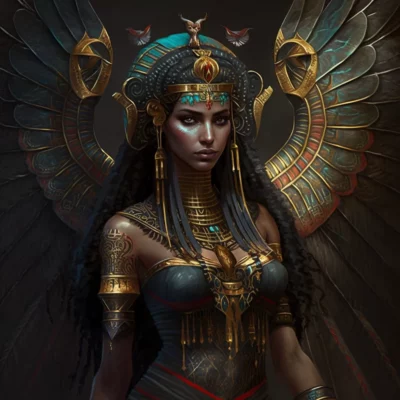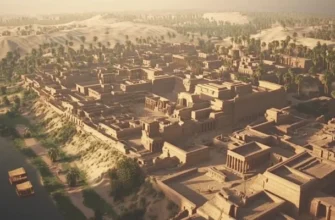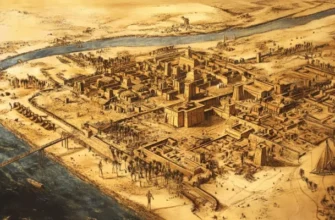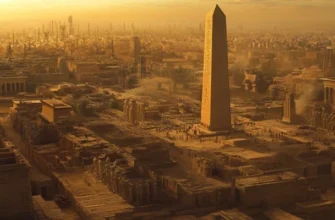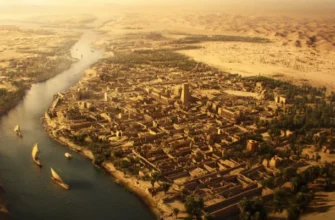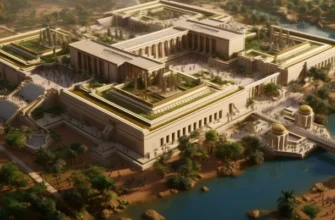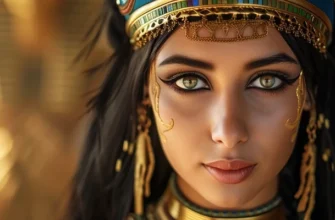The Egyptian goddess Isis is one of the most important deities in Egyptian mythology and religion. She was revered as the goddess of motherhood, female beauty, magic, and wisdom. Isis was also a symbol of fertility, science and art. In mythology, she was the wife of the god Osiris and the mother of the god Horus. Isis was depicted as a woman wearing a crown consisting of three pyramids and often holding symbols of her power, such as a rod and a magic knot. Her cult was widespread throughout Egypt, and her influence can be seen in architecture, sculpture, and other forms of Egyptian art. In this article, we will look at the history, characteristics, and role of Isis in Egyptian mythology and religion, as well as her reflection in the modern world.
- History and significance of the goddess Isis
- The importance of Isis in Egyptian mythology and religion
- The transformation of the cult of Isis over time
- Characteristics and attributes of the goddess Isis
- Characteristics of the goddess Isis
- Attributes and symbols of Isis
- The role of the goddess Isis in Egyptian mythology and religion
- Stories and legends about Isis
- Religious rites and rituals associated with Isis
- The role of Isis in the Egyptian pantheon
- Worship of the goddess Isis in the modern world
- Modern research and discoveries about Isis
- The role of Isis in modern beliefs and traditions
- The popularity of the goddess Isis in art and culture
- Conclusions.
History and significance of the goddess Isis
Life in Ancient Egypt was associated with religion and belief in many gods and goddesses. One of the most important deities in Egyptian mythology and religion was the goddess Isis. She was revered as the goddess of motherhood, female beauty, magic, and wisdom. Isis was also a symbol of fertility, science, and art.
In Egyptian mythology, Isis was the wife of the god Osiris and the mother of the god Horus. Her cult was widespread throughout Egypt, and her influence can be seen in architecture, sculpture, and other forms of Egyptian art. Isis was depicted as a woman wearing a crown made up of three pyramids and often holding symbols of her power, such as a rod and a magic knot.
The veneration of Isis was widespread not only in ancient Egypt, but also in the modern world, where she can represent feminine power, motherhood, and wisdom.
The importance of Isis in Egyptian mythology and religion
Isis was very important in Egyptian mythology and religion. She was one of the most important deities and was revered as a symbol of motherhood, female beauty, magic, and wisdom. She was also a symbol of fertility, science and art.
In Egyptian mythology, Isis played an important role. She was the wife of the god Osiris and the mother of the god Horus, which allowed her to be considered a maternal principle that ensured the preservation of order in the cosmos. Isis also played the role of the deity of wisdom and learning, and her magical abilities helped people understand the world around them and fight evil.
The worship of Isis was widespread not only in ancient Egypt but also in the modern world. Her image can be seen in contemporary Egyptian art and in the art of other countries, and her symbolism can be used to represent female power, motherhood, and wisdom.
The transformation of the cult of Isis over time
The cult of Isis has undergone various transformations over time. Starting in ancient Egypt, her cult spread to other countries of the Middle East and the Mediterranean. During the Roman Empire, Isis was included in the pantheon of Roman gods, where she occupied a significant position. During this period, the cult of Isis evolved into a mystical cult associated with a common belief in the afterlife and the rebirth of the soul.
In Christian times, the cult of Isis experienced the influence of the Christian church, which tried to destroy pagan religious cultures. However, the cult of Isis managed to survive and retained its popularity in certain regions of the world where it had long been banned or forgotten.
Today, Isis is an object of study for scholars and researchers of ancient Egyptian culture. The cult of Isis is part of the world’s cultural heritage and art, its symbolism is widely used in contemporary art and design, and continues to arouse interest and admiration among people around the world.
Characteristics and attributes of the goddess Isis
Isis was one of the most important goddesses in Egyptian mythology, and her characteristics and attributes were important elements of Egyptian religion and cult.
One of the main characteristics of Isis was her majesty and wisdom. She was considered the goddess of magic, wisdom, fertility, protection, and healing. Isis was often depicted as a mother goddess who gave her favor and protection to her worshippers. She is also known as the goddess of life, resurrection, and the afterlife.
Isis’s attributes included a crown made from a headdress of the Nile, symbolizing her power over the river, as well as an eagle and a feather, symbolizing wisdom. Other attributes of Isis included the image of a falcon representing her husband, the god Osiris, as well as a lotus flower symbolizing fertility.
In general, the attributes and characteristics of Isis reflect her important place in Egyptian religion and culture, her role as a goddess of protection and wisdom, who endowed her worshipers with favor and protected them from evil.
Characteristics of the goddess Isis
Isis is one of the most famous and respected goddesses of Egyptian mythology, who had numerous characteristics, including the following:
Wisdom and majesty – Isis was considered the goddess of magic, wisdom, and fertility, who protected her worshippers.
The goddess of protection – Isis was a symbol of maternal love and care, protecting her worshippers from various adversities and evil.
The goddess of healing – Isis is also known for her healing abilities, which she passed on to her messengers.
Goddess of life – Isis played an important role in beliefs about the afterlife and rebirth, as well as in the lives of Egyptian women.
Attributes – Isis was depicted with a lotus flower in her hair, a falcon on her head, an elderly man and a feather in his hands, and an image of the god Osiris next to her.
Cult – Isis had numerous followers who paid homage to her in various forms of worship.
All these characteristics and attributes make Isis one of the most important goddesses of Egyptian mythology, who had a great influence on the culture and religion of ancient Egypt.
Attributes and symbols of Isis
Isis had numerous attributes and symbols that reflected her characteristics and power. The most famous of them include:
Lotus – Isis was often depicted with a lotus flower in her hair, symbolizing beauty and fertility.
Falcon – Isis was often depicted with a falcon on her head, symbolizing her protective power and authority over the heavens.
Summer and a feather – Isis was also often depicted with a summer and a feather in her hand, which symbolized her abilities to wisdom and magic.
Osiris – Isis was the wife of Osiris, the god of rebirth and protector of the afterlife. They were often depicted side by side.
Ankh – Sometimes Isis was also depicted with an ankh, a symbol of life and eternity.
All of these attributes and symbols were important parts of the Isis cult and symbolized her power over various aspects of life and religion in ancient Egypt.
The role of the goddess Isis in Egyptian mythology and religion
The goddess Isis played an important role in Egyptian mythology and religion. She was one of the most revered goddesses and mother goddesses, symbolizing maternal love, fertility, wisdom, and magic. Isis was also a goddess of power and protection, whom people turned to for help in various situations in life.
In mythology, Isis was the wife of Osiris, the god of rebirth and protector of the afterlife. She helped him, after he was killed by his brother Seth, to find the appropriate rituals and ceremonies to be reborn and become a god of the afterlife. Her son Horus, the god of heaven, also turned to her for help in his struggles against evil forces.
In addition, Isis was considered the goddess of magic and wisdom, who taught people how to use spells and enchantments. She was also the patron saint of doctors and medicines, and religious festivals were held in her honor, during which healing rites were performed.
In general, Isis played an important role in Egyptian mythology and religion as a symbol of maternal love and fertility, a protector, a magician, and a sage. Her cult was widespread throughout ancient Egypt and had a significant impact on the religious life of that country.
Stories and legends about Isis
There are many stories and legends associated with the goddess Isis that have been passed down from generation to generation in Egyptian mythology. One of the most famous stories is related to the search for her male brother Osiris, who was killed by his brother Seth and dismembered into pieces. Isis put all his parts together to restore his life. After Osiris was reborn, he became the underground ruler of the land of the dead, and Isis became his protector and guardian.
Another legend is related to the birth of Isis, who was considered the daughter of the god Ra. According to this story, Isis was born on an island when her mother Nut was imprisoned in heaven and her father Geb was lying on the ground. Isis became the goddess of motherhood and child protection, and her symbol is a figure with a child on her lap.
Isis was also associated with magic and healing. In one story, Isis cured the sun god Ra of a fatal illness by using her magical knowledge and spells.
All of these stories and legends are important parts of Egyptian mythology and religion that helped people understand the world and nature.
Religious rites and rituals associated with Isis
Isis is a goddess in Egyptian mythology who was considered the patroness of motherhood, fertility, and female beauty. Her image was depicted with a forehead decorated with horns, as well as a shroud and breasts that symbolized her maternal nature.
In Egyptian religion, Isis was an important goddess, so her rites and rituals were of great importance to the population. Here are some of them:
The rite of “Isis’ descent into the Nile”. This rite took place in early summer, when the Nile’s water was rising. Its purpose was to invite Isis to the city and offer her fresh flowers and fruits so that she could bring fertility to the region.
The rite of “Restoring the Eye of Horus”. It is associated with the myth of Isis and her husband Osiris. According to the legend, Osiris was killed by his brother and dismembered into pieces, and Isis collected his parts and restored his body. The ritual involved griffins entering the shrine and bringing a potion that restored the damaged eye.
The Isis Widow Rite. This rite is dedicated to the memory of Isis’ husband Osiris. Women played the main role in it, and they portrayed Isis the widow mourning her deceased husband. The ritual was held in the dark night, and women with candles walked the streets and shouted the names of the gods.
The ritual of “Lighting the Fire of Isis”. This rite was performed in honor of Isis and was supposed to symbolize her light. People gathered around the fire and asked the goddess to give them happiness and prosperity by singing and dancing.
The ritual of the Coronation of the Pharaoh. This rite was attended by Isis and her husband Osiris, as well as their sons Horus and Seth. This rite was important to the Egyptian people because it symbolized the transfer of power from the gods to the pharaoh.
The rite of Isis pilgrimage. This rite took place in early summer and was supposed to symbolize the beginning of the new year. People gathered on the banks of the Nile and immersed small boats with images of Isis and her husband in the water. This rite also served as a symbol of purification and a new beginning.
These rites and rituals associated with Isis reflected important aspects of Egyptian religion, such as the veneration of the gods, nature, and the life cycle. They also reflected cultural and social meanings for the population, as their celebration was an important event for the community.
The role of Isis in the Egyptian pantheon
Isis played a very important role in the Egyptian pantheon, as she was considered one of the most famous and revered goddesses in Egyptian mythology. She was the goddess of motherhood, family, science, art, craft, wisdom, and magic.
Isis was often depicted as a woman with horns that bore the sun and a star between them. This symbolized her role as goddess of the sky and stars. Her other attributes included wings, fans, a lotus, amulets, and others.
Isis was also an important figure in mythology, as her story is connected to the death and resurrection of her husband Osiris. Isis played a major role in the revival of Osiris and became the mother of their son Horus.
Isis also played an important role in people’s lives, as her cult was widespread throughout Egypt. People prayed to her for health and well-being, as well as for protection during childbirth. She was also the patron saint of magicians and doctors who believed they could receive power and wisdom from the goddess.
Thus, Isis played an important role in the Egyptian pantheon and in the culture of the time, symbolizing various aspects of people’s lives and beliefs. She was a revered and honored goddess who occupied a high place in the middle of the Egyptian religion.
Worship of the goddess Isis in the modern world
Today, Isis remains an important figure in the religious and spiritual traditions of some groups of people. Although the veneration of Isis is not an everyday practice, she still has her supporters and admirers who associate her with various aspects of life.
Some believers maintain the cult of Isis as part of Egyptian tradition. They dedicate their prayers and rituals to Isis, which are related to various aspects of life, such as motherhood, family, wisdom, and art.
Other believers, particularly in contemporary Egyptian culture, may use the image of Isis as a symbol of Egyptian heritage and culture. She may appear in art, literature, and other forms of culture as a symbol of various aspects of life, such as wisdom, beauty, and motherhood.
In general, although the veneration of Isis is not a widespread practice in the modern world, her image can be used as a symbol of various aspects of life and culture, and can serve as a source of inspiration for the faithful and spiritual seekers.
Modern research and discoveries about Isis
Modern research and archaeological excavations continue to expand our knowledge of Isis and Egyptian mythology in general. For example, fragments of myths, images, and religious texts found on the walls of temples help us better understand the role of Isis in Egyptian culture and her place in the pantheon of gods.
One of the most significant discoveries about Isis was made in 2017, when a team of archaeologists discovered a long, narrow corridor that hid a mysterious cult hall of Isis in the temple of Pharaoh Seti I in the ancient city of Abydos. Several large statues of Isis were found in this hall, as well as a number of rare mythological images and texts.
Researchers also continue to explore Isis’ connections to other goddesses and cultures. For example, some research suggests possible connections between Isis and the Greek goddess Demeter, who were both goddesses of agriculture and motherhood. It has also been found that Isis may be connected to African traditions of honoring mother earth.
In general, modern research and discoveries help to expand our knowledge of Isis’ role in Egyptian culture and her place in the pantheon of gods, as well as the connections between Isis and other goddesses and cultures.
The role of Isis in modern beliefs and traditions
Although Isis is not an active object of cultic worship in modern Egyptian beliefs, her image and symbolism are still used in some religious traditions and rituals. For example, in some Christian churches in Egypt, Isis is depicted as the Holy Virgin Mary, symbolizing her role as a mother goddess.
In addition, ideas related to Isis and her role as a goddess of motherhood and protection are used in some modern spiritual development and alternative medicine practices. For example, some believers pay homage to Isis as a maternal divine force who can assist in the birth process, and as a patroness of women and children.
Additionally, some groups practice modern variations of ancient Egyptian rituals, including rituals associated with Isis and her consort Osiris. For example, there are groups that perform rituals using mythological symbols and tools associated with Isis and her cult.
In general, the role of Isis in modern beliefs and traditions can be quite diverse and individual, depending on the context and cultural tradition, but the image of Isis and her symbolism still has meaning for many people.
The popularity of the goddess Isis in art and culture
The goddess Isis is very popular in world culture and art. Her image and symbolism have been used in various artistic forms, including literature, painting, sculpture, and film.
In medieval and Renaissance literature, the goddess Isis was often mentioned as a symbol of kindness and feminine power. Her image was used in many works, including Dante Alighieri’s Divine Comedy and William Shakespeare’s Antony and Cleopatra. Other literary works that have connections to Isis include Amela Ljungdahl’s Isis and Margaret Atwood’s Isis.
In art, the goddess Isis was often depicted as a beautiful woman with her head covered by a veil or tall crown, usually seated on a throne and holding symbols of power and feminine strength. Her image can be seen on many different artworks, including Egyptian temples, statues, mosaics, murals, and other religious artifacts.
In movies and television, the goddess Isis is also used as a symbol of female power and maternal love. For example, in the films “The Oath of Pharaoh” (1957) and “John Carter” (2012), there are characters called Isis. In addition, the goddess Isis is one of the characters in the popular video games of the Assassin’s Creed series.
In general, the goddess Isis is an important symbol that is sometimes used to represent various aspects of female power, such as maternal love, tenderness, patience, and wisdom. Her symbolism differs from culture to culture, but in general, her image is associated with the sky, earth, moon, and stars.
In general, the goddess Isis is an important figure that has been important to people in different eras and cultures. Her image has been used in different contexts, allowing us to better understand the history and culture of ancient Egypt, as well as its influence on the modern world.
Conclusions.
In summary, the goddess Isis played an important role in the culture and history of ancient Egypt. Her cult was widespread and well-known not only in Egypt but also abroad, and it had a significant impact on other cultures of the time. Isis was considered the goddess of motherhood, female power, wisdom, and magic, as well as a goddess who could help the dead in the afterlife.
Modern research and discoveries are helping to expand our knowledge of Isis and her cult. And although Isis is no longer a goddess revered in a traditional religious context, she remains an important symbol for many people, especially those seeking a spiritual connection to the world around us.
We call for further research into Isis and her influence on the culture and history of ancient Egypt, as well as her significance in the modern world. Understanding Isis and her role can help us to better understand ancient traditions and cultures, as well as their impact on the modern world.
